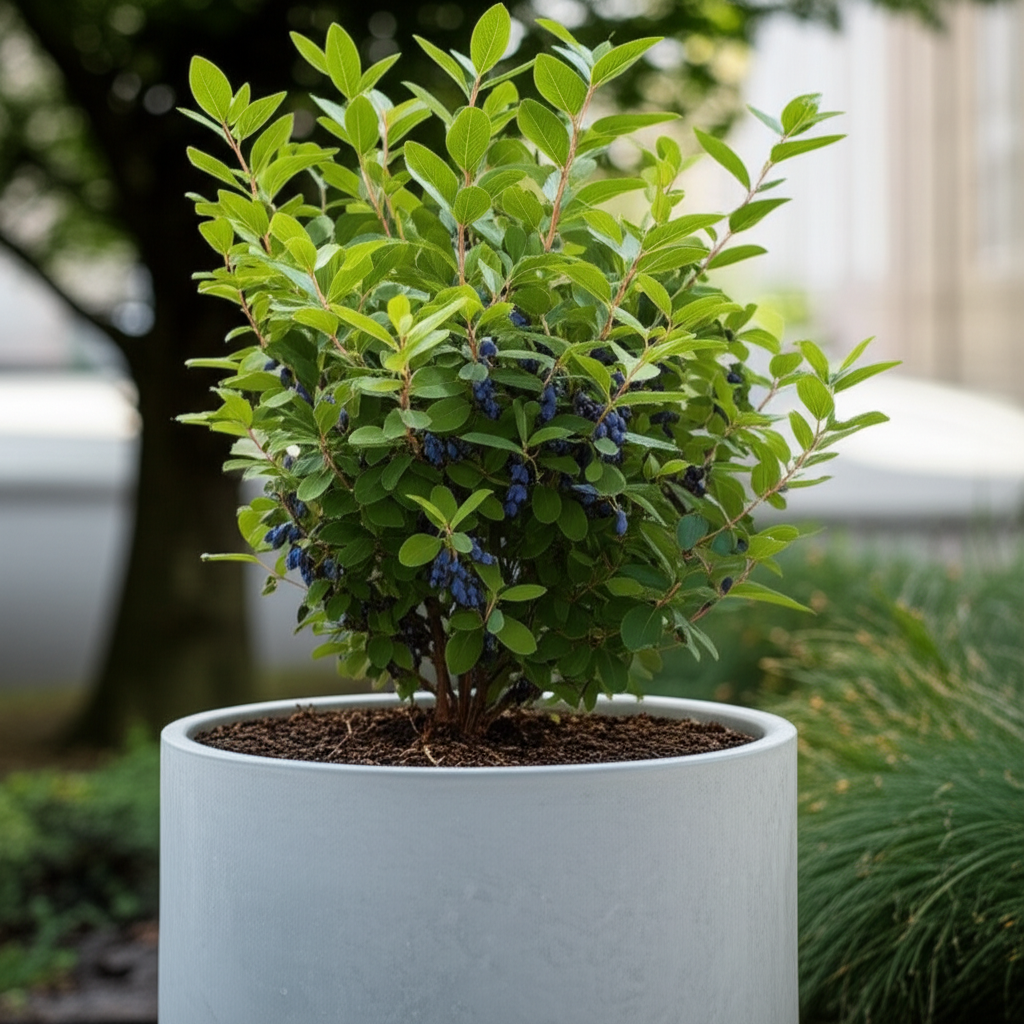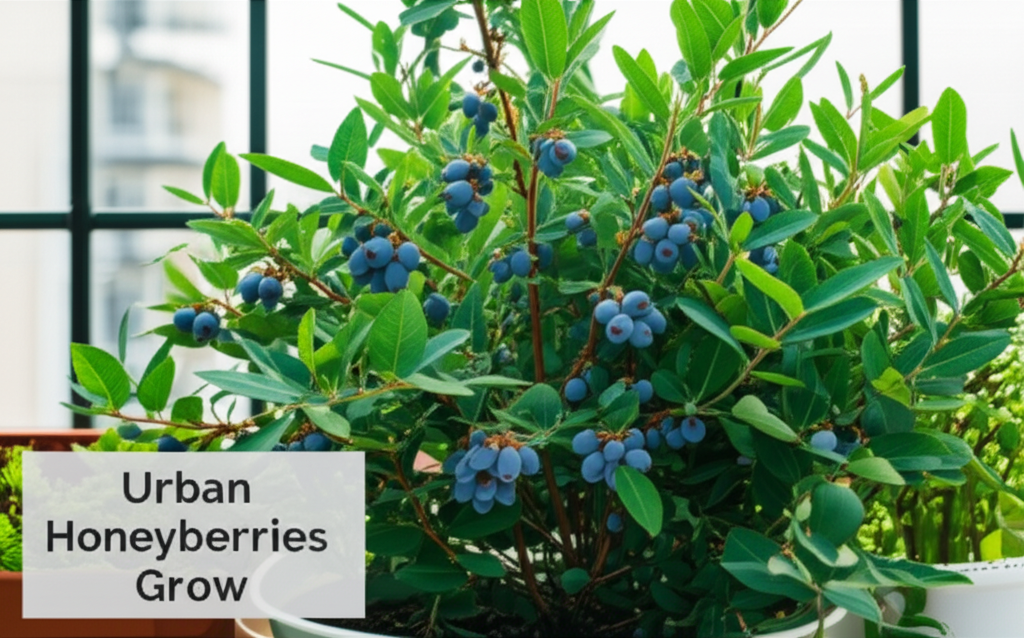Discovering the Charm of Honeyberries in Compact Urban Spaces
For urban dwellers with limited garden real estate, the dream of growing fresh, delicious fruit can often seem out of reach. However, the world of horticulture offers delightful solutions, and among them, the honeyberry shrub (also known as Haskap) stands out as a particularly rewarding choice for small urban spaces. These hardy, adaptable plants are not only incredibly productive but also remarkably low-maintenance, making them an ideal candidate for balconies, patios, and compact backyards.
The honeyberry, scientifically classified as Lonicera caerulea, is a fascinating member of the honeysuckle family. Unlike its ornamental cousins, this species has been cultivated for its edible, berry-like fruit, which boasts a unique flavour profile often described as a blend of blueberry, raspberry, and blackcurrant. These nutrient-dense berries are rich in antioxidants, vitamins, and fibre, offering a healthy and delicious addition to any diet.
Why Honeyberries are Perfect for Urban Gardening
The compact nature of many honeyberry varieties, coupled with their impressive resilience, makes them a standout choice for city gardeners. They tolerate a range of soil types, can withstand cold winters, and are relatively pest and disease resistant. This means less fuss and more delicious fruit, even for those with minimal gardening experience or time.
Key Characteristics of Honeyberry Shrubs
Before delving into the specifics of growing honeyberries in urban settings, it’s important to understand their fundamental characteristics. This will help in selecting the right varieties and providing optimal growing conditions.
| Characteristic | Description |
|---|---|
| Botanical Name | Lonicera caerulea |
| Common Names | Honeyberry, Haskap, Edible Honeysuckle, Blue Honeysuckle |
| Origin | Northern Asia (Siberia, Japan, Russia) |
| Mature Size | Typically 4-6 feet tall and wide (varies by cultivar) |
| Fruit | Oblong, blue-purple berries (similar to blueberries) |
| Flavour | Tart and sweet, often compared to a mix of blueberry, raspberry, and plum |
| Hardiness Zones | 3-7 (exceptionally cold-hardy) |
| Sun Requirements | Full sun to partial shade |
| Soil Requirements | Well-drained, slightly acidic to neutral pH |
| Pollination | Requires cross-pollination from a different honeyberry variety |
| Fruiting Time | Late spring to early summer (often the first fruit of the season) |
Choosing the Right Honeyberry Varieties for Your Urban Oasis

The success of your honeyberry cultivation hinges on selecting the right varieties. Fortunately, breeders have developed numerous cultivars specifically suited for different climates and garden sizes. For small urban spaces, dwarf or semi-dwarf varieties are particularly appealing.
Considerations for Small Spaces
When selecting a honeyberry cultivar for a compact urban garden, consider the following:
- Mature Size: Opt for varieties that naturally stay smaller to avoid overcrowding.
- Pollination Partners: Remember that honeyberries need at least two different varieties planted near each other for optimal fruit production. Choose compatible cultivars.
- Fruiting Time: If you want an extended harvest or to be among the first to taste fresh berries, look for early-fruiting varieties.
Popular Honeyberry Cultivars for Urban Gardens
Here are some excellent honeyberry varieties known for their suitability in smaller gardens and their delicious fruit:
- ‘Tundra’: A hardy and productive variety known for its large, flavourful berries. It has a semi-dwarf growth habit.
- ‘Honeybee’: This cultivar produces abundant, juicy berries with a good balance of sweetness and tartness. It’s a reliable pollinator.
- ‘Borealis’: Offers large, sweet berries and is a good pollinator for other varieties. It grows to a manageable size.
- ‘Aurora’: Known for its attractive plant habit and flavourful, firm berries. It’s a robust and hardy choice.
- ‘Perfection’: As the name suggests, this variety is prized for its excellent flavour and good yields. It has a compact growth form.
It’s important to research specific cultivars available in your region and their recommended pollination partners to ensure a bountiful harvest.
Cultivating Honeyberries: From Container to Balcony Bliss
Growing honeyberries in small urban spaces is entirely achievable, whether you have a small patch of soil, a patio, or even a sunny balcony. The key is to provide them with the right conditions and a little care.
Container Gardening with Honeyberries
For urban dwellers, container gardening is often the most practical approach. Honeyberries adapt well to life in pots, allowing you to control the soil and drainage.
Choosing the Right Container
- Size: Select a container that is at least 15-20 gallons in volume for a mature plant. This will allow for adequate root growth.
- Material: Terracotta, fabric pots, or sturdy plastic containers are all suitable. Ensure they have drainage holes.
- Drainage: Good drainage is crucial to prevent root rot. Consider adding a layer of gravel or broken pottery at the bottom if your container doesn’t have ample drainage holes, though good potting mix is the primary solution.
Potting Mix
Use a high-quality potting mix that is well-draining. A blend of compost, peat moss or coco coir, and perlite or coarse sand works well. You can also amend existing garden soil with compost and sand for better drainage if planting directly in a raised bed.
Planting and Location
Honeyberries thrive in full sun (at least 6-8 hours per day) but can tolerate partial shade. In urban environments, identify the sunniest spot available, whether it’s a south-facing balcony, a sunny patio, or a small garden bed.
Spacing
If planting multiple honeyberry shrubs, ensure adequate spacing for cross-pollination. Aim for 3-5 feet between plants. In containers, you can place two different varieties in a large planter, ensuring their branches can touch for pollination.
Watering and Feeding
Consistent moisture is important, especially during the establishment phase and during fruit development.
- Watering: Water thoroughly when the top inch of soil feels dry. Container-grown plants will typically require more frequent watering than those in the ground, especially during hot weather.
- Fertilizing: Honeyberries are not heavy feeders. A balanced, slow-release fertilizer applied in early spring before new growth appears is usually sufficient. Over-fertilizing can lead to excessive leafy growth at the expense of fruit.
Pollination: The Key to a Bountiful Harvest
This is a critical aspect of growing honeyberries. As mentioned, most honeyberry cultivars require cross-pollination to produce fruit. This means planting at least two different varieties that bloom at the same time.
- Planting Strategy: Place your honeyberry plants relatively close to each other (within 3-5 feet) to facilitate pollination by wind and insects.
- Bloom Time: Ensure your chosen varieties have overlapping bloom times. Most cultivars are bred to be compatible, but it’s always wise to check the specific bloom periods when purchasing.
Care and Maintenance for Thriving Honeyberry Shrubs
Honeyberries are renowned for their resilience, but a little basic care will ensure they flourish and provide you with abundant harvests year after year.
Pruning Honeyberries
Pruning is essential for maintaining the health, shape, and productivity of your honeyberry shrubs. The best time to prune is in late winter or early spring while the plant is dormant.
Pruning Goals
- Remove dead, damaged, or diseased wood.
- Improve air circulation within the plant.
- Encourage new growth and fruit production.
- Maintain a manageable size for your urban space.
Pruning Techniques
- Young Plants: Focus on establishing a strong framework by pruning to create 3-5 main branches.
- Mature Plants: Remove any weak or crossing branches. Thin out older stems to encourage new, more fruitful growth. Aim to remove about one-third of the oldest stems each year.
Pest and Disease Management
Honeyberries are generally quite resistant to pests and diseases. This is one of their major advantages for urban gardening, where managing pests can be challenging.
Common Issues (Rare)
- Birds: Birds are the most likely culprits to enjoy your berries before you do! Netting or reflective deterrents can be used to protect ripening fruit.
- Aphids: In rare cases, aphids might infest new growth. A strong blast of water or insecticidal soap can usually manage them.
- Powdery Mildew: This fungal disease can occur in humid conditions. Proper air circulation through pruning helps prevent it.
Harvesting Your Delicious Honeyberries
The reward for your efforts comes with the harvest! Honeyberries typically ripen in late spring to early summer, often being one of the first fruits available.
- When to Harvest: Berries are ready to pick when they are a deep blue-purple colour and have a slightly soft texture. They may still have a bit of tartness, which is characteristic of their flavour.
- How to Harvest: Gently pull the berries from the stem. They usually detach easily when ripe. You can harvest them individually or gently shake a branch over a container to collect them.
Troubleshooting Common Honeyberry Growing Challenges in Urban Settings
While honeyberries are generally easy to grow, urban environments can present unique challenges. Here’s how to address them.
Lack of Fruit Production
If your honeyberry shrubs aren’t producing fruit, the most common reason is insufficient pollination.
Solutions:
- Ensure you have at least two different honeyberry varieties planted within pollination range.
- Check that their bloom times overlap.
- Attract pollinators like bees by planting companion flowers nearby, even on balconies.
Poor Berry Flavour
Occasionally, berries might be too tart or lack sweetness.
Solutions:
- Ensure adequate sunlight; insufficient sun can lead to less flavourful fruit.
- Proper watering and avoiding drought stress are important for flavour development.
- Some cultivars are naturally tarter than others; choose sweeter varieties if flavour is paramount.
Container Drainage Issues
Waterlogged roots are detrimental to any plant.
Solutions:
- Always use pots with drainage holes.
- Use a well-draining potting mix.
- Avoid overwatering; check soil moisture regularly.
Limited Space Management
Keeping plants tidy and manageable in small spaces is key.
Solutions:
- Choose dwarf or semi-dwarf varieties.
- Regular pruning will help maintain shape and size.
- Consider espaliering or training plants on a small trellis for vertical growth.
| Pros of Honeyberry Shrubs in Urban Spaces | Cons of Honeyberry Shrubs in Urban Spaces |
|---|---|
| Compact Size: Many varieties are naturally small and well-suited for containers or small beds. | Need for Cross-Pollination: Requires planting at least two different varieties, which might seem like a lot for a very small space. |
| Cold Hardiness: Tolerant of harsh winter conditions common in many urban climates. | Bird Predation: Ripe berries can be a target for birds, requiring protective measures. |
| Low Maintenance: Generally resistant to pests and diseases, requiring minimal intervention. | Early Bloomers: Can sometimes be caught by late frosts, potentially impacting fruit set. |
| Nutrient-Rich Fruit: Berries are packed with antioxidants and vitamins. | Tartness: Some varieties can be quite tart, which might not appeal to everyone’s palate. |
| Early Fruiting: Often the first fruit to ripen in the season, providing an early harvest. | Container Care: Requires consistent watering and monitoring in pots, which can be more demanding than in-ground planting. |
| Adaptable to Containers: Grow very well in pots on balconies or patios. | Specific Soil Needs: Prefer well-drained, slightly acidic to neutral soil, which might need amending in some urban areas. |
The Sweet Rewards: Enjoying Your Urban Honeyberry Harvest
Growing honeyberries in your small urban garden is a rewarding experience that offers both aesthetic appeal and delicious, healthy fruit. These resilient shrubs are a testament to the fact that even the most limited spaces can yield a bounty of fresh produce.
Whether you’re enjoying them fresh, blending them into smoothies, baking them into pies, or making jams and jellies, the taste of homegrown honeyberries is unparalleled. Their vibrant blue hue and unique flavour profile will make them a cherished addition to your urban edible landscape. So, embrace the possibility, select your varieties, and get ready to savour the sweet surprise of honeyberries right outside your door.


